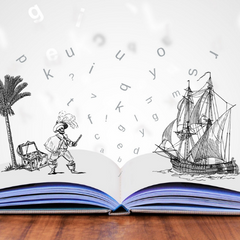
Ever feel like your emails are disappearing into a black hole?
You’re not alone.
Crafting an email newsletter that stands out in today’s crowded inbox is no small feat.
But here’s the good news:
Mastering newsletter copywriting isn’t as hard as you might think.
In 2024, the digital landscape is more competitive than ever. Your audience is bombarded with information from all sides. Yet, there’s a secret weapon that can slice through the noise—an irresistible email newsletter.
Today, we’re diving deep into the art and science of newsletter copywriting.
By the end of this guide, you’ll have a toolkit of strategies, insider secrets, and actionable tips to craft newsletters that not only get opened but also drive results.
What is Newsletter Copywriting?

Newsletter copywriting is the art of crafting compelling content specifically for email newsletters.
Unlike other forms of writing, it combines the principles of direct response copywriting with the nuances of digital communication.
The goal?
To engage, inform, and ultimately convert your readers.
Imagine this:
You’re sitting down with a cup of coffee, and your favorite email newsletter hits your inbox. You open it, and from the very first line, you’re hooked. You start reading and find yourself nodding along, scrolling eagerly to see what’s next. Before you know it, you’ve read the entire email and you’re compelled to click on the link. That’s the power of effective newsletter copywriting. It’s about understanding your audience so well that your emails feel like a conversation rather than a sales pitch.
The 5 Core Components of an Email Newsletter
To create a high-performing email newsletter, you need to master five core components: the from name, subject line, lead, body copy, and close.
- From Name: Use your own name or your client’s name, NOT the company or brand name. Personalization builds trust and makes your newsletter feel more like a one-on-one conversation. People like hearing from people they like, know and trust, not faceless corporations.
- Subject Line: This is your first impression—make it count. A great subject line grabs attention and entices your reader to open your email. Think of it as the gateway to your content.
- Lead: The opening lines of your email need to hook your readers immediately. Start with a story, a startling fact, or a question that piques curiosity. The lead sets the tone and draws your readers in.
- Body Copy: This is where you deliver the meat of your message. Keep it engaging, informative, and relevant to your audience. Use short paragraphs, bullet points, and subheadings to make it easy to read and easy to get to your CTA.
- Close: End with a strong call to action. Whether you want your readers to click a link, reply to your email, or take another specific action, make it clear and compelling.
Master these components, and you’ll be well on your way to creating email newsletters that skyrocket results for yourself and/or your clients.
10 Insider Secrets for Writing Engaging Email Newsletters that Drive Results
Creating engaging email newsletters that drive results requires a mix of creativity, strategy, and a deep understanding of your audience & direct response copywriting principles.
Here are 10 insider secrets to help your emails stand out in your readers’ inbox and convert them into happy customers.
1. Know Your Audience Inside Out

The first step to writing riveting newsletter copy is understanding your audience.
What are their pain points? What kind of content do they find valuable? What problems are they trying to overcome?
Conduct surveys, analyze your audience’s behavior, and create detailed buyer personas to tailor your newsletters to their needs and interests.
By knowing your audience, you can speak directly to their desires and challenges, making your email newsletter feel personal and relevant.
2. Start Your Emails with a Story

A few years ago, I was working on a campaign for a client who ran a small bakery. We needed to increase engagement with their email newsletter. Instead of jumping straight into promotions or news, I suggested starting each email with a personal story from the bakery’s owner.
The owner began sharing little anecdotes about her daily life at the bakery—like the time she experimented with a new muffin recipe and ended up with a kitchen disaster, or how a customer’s story inspired a new flavor. These personal touches made the emails more relatable and engaging.
Here's why starting with a relevant, personal story works:
- Builds Connection: Personal stories create an emotional bond between you and your readers.
- Engages from the Start: A good story hooks your reader from the first line and keeps them interested.
- Humanizes Your Brand: It shows there are real people behind the business, making your emails feel more authentic and less salesy.
- Persuades better than features & benefits: Stories that your audience can identify with and create a vision of your reader’s problems, desires, dreams, etc. are far more persuasive than blabbering on about your products features & benefits.
So, when writing your newsletter copy, begin with a story. Share something personal and relevant to the topic of your email.
3. Focus on One Main Idea
In newsletter copywriting, clarity is key.
One of the best ways to ensure your email newsletter is effective is to focus on one major idea or lesson throughout the email.
This singular focus helps keep your message clear and makes it easier for your readers to absorb and act on your content.
Here’s how:
- Identify Your Main Idea: Determine the primary message you want to convey in your email. This could be a valuable tip, an insightful observation, or an important update.
- Stay On Topic: Resist the temptation to include multiple ideas or messages. Keep everything in your email centered around your main idea.
- Reinforce Your CTA: Tie your main idea directly to your call to action (CTA). For instance, if your email is about the benefits of a new product, ensure your CTA encourages readers to learn more about or purchase that product.
By focusing on one major idea, you make your newsletter copy more impactful and ensure your readers are not overwhelmed with information.
This approach not only enhances readability but also increases the likelihood that your audience will follow through on your CTA.
4. Write in a Conversational Tone

Think about the last time you read a really engaging email newsletter. Chances are, it felt like a personal conversation rather than a formal announcement.
Writing in a conversational tone is one of the most effective ways to connect with your readers and keep them engaged.
Here’s how to nail that conversational tone:
- Use Simple Language: Avoid jargon and complex words. Write as if you’re talking to a friend.
- Ask Questions: Engage your readers by asking questions throughout your email. It makes them feel involved and prompts them to think about their own answers.
- Use Personal Pronouns: Words like "you" and "I" make your emails feel more personal and direct.
- Include Small Talk: Just like in a real conversation, a bit of small talk can make your emails more relatable. Mention the weather, a recent event, or a common experience.
- Speak Your Target Audience’s Language: Use phrases and terminology that resonate with your audience. Understanding and mimicking their language helps you connect on a deeper level and makes your content feel more relevant.
By adopting a conversational tone, you make your newsletter copy more approachable and enjoyable to read.
This helps build a stronger relationship with your audience, encouraging them to read your emails regularly and take action on your CTAs.
5. Stay in Your Reader's World
If you want to create email newsletters that captivate and engage, you need to stay in your reader’s world.
Write about what interests them, and you’ll never bore them.
Here's how to do it:
- Understand Their Interests: Conduct surveys, read comments, and engage with your audience on social media to learn what they care about. Tailor your content to their preferences.
- Solve Their Problems: Address the challenges and pain points your readers face. Offer solutions, tips, and advice that can help them overcome these issues.
- Stay Relevant: Keep up with trends and hot topics in your industry. If something is currently a big deal in your readers' world, make sure you’re talking about it.
- Use Their Language: Speak in a way that resonates with your audience. Use the terminology and style they’re familiar with to create a connection.
6. Use Analogies and Metaphors
Analogies and metaphors are powerful tools in newsletter copywriting.
They can make your messages clearer, more engaging, and easier to understand.
Think of them as the seasoning that adds flavor to your writing. Just as a good chef uses spices to enhance a dish, a skilled copywriter uses analogies and metaphors to bring their content to life.
Imagine your reader is navigating a dense forest of information. Your role is to be their guide, cutting through the underbrush with the machete of clarity. Instead of saying, "Our product is easy to use," you might say, "Using our product is as easy as riding a bike—you’ll get the hang of it in no time."
Analogies can simplify complex ideas. For instance, if you’re explaining a complicated process, compare it to something familiar. "Think of our email automation system as a well-oiled machine, effortlessly sorting and delivering your messages exactly where they need to go."
Metaphors can also make your content more memorable. Describing a marketing strategy as a "roadmap to success" creates a vivid image in your reader’s mind, making the concept easier to grasp and remember.
By using analogies and metaphors, you not only entertain and engage your readers but also make your messages more relatable and understandable. This approach can transform dry, technical information into compelling, easy-to-digest content that keeps your audience hooked.
7. Leverage Social Proof

Adding social proof into your email newsletters can significantly boost your credibility and persuade your readers to take action.
Social proof is all about showing your audience that others trust and value what you’re offering. This can be done through testimonials, case studies, user reviews, or even endorsements from industry experts.
Think about it…
When you’re considering a new product or service, you’re more likely to make a decision if you see that others have had positive experiences. It’s like being at a restaurant and seeing that every table is full—you immediately think the food must be good.
Here’s how to effectively leverage social proof in your newsletter copy:
- Testimonials: Share quotes from satisfied customers. Highlight specific benefits they’ve experienced to make it relatable and compelling.
- Case Studies: Tell success stories of how your product or service has helped others. Provide concrete examples and results to back up your claims.
- User Reviews: Include snippets of reviews from platforms like Google, Yelp, or Amazon. Genuine reviews from real users can be incredibly persuasive.
- Expert Endorsements: If industry experts or influencers have endorsed your product, feature their quotes and recommendations. This adds a layer of authority to your message.
By showcasing social proof, you build trust with your audience and make it easier for them to believe in the value of what you’re offering.
8. Use Clear and Compelling Calls to Action (CTAs)

Your email newsletter might be packed with valuable content, but without a clear and compelling call to action (CTA), all that effort could go to waste.
A strong CTA guides your readers on what to do next, whether it's making a purchase, signing up for a webinar, or simply clicking through to read more on your website.
Think of your CTA as the closing argument in a persuasive case. It needs to be clear, direct, and compelling to prompt immediate action. Here’s how to craft CTAs that drive results:
First… be specific about what you want your readers to do. Instead of a vague "Click here," use action-oriented language that tells them exactly what to expect, such as "Download your free guide now" or "Join our exclusive webinar."
Second… create a sense of urgency. Phrases like "limited time offer," "only a few spots left," or "get it before it’s gone" can encourage your readers to act quickly rather than putting it off.
Third…make your CTA stand out visually. Use buttons or bold text to draw attention to your CTA. The more prominent it is, the more likely your readers will notice and click on it.
And, last but not least, ensure that your CTA is relevant to the content of your email. If you’ve been discussing a particular product or topic, your CTA should naturally lead from that discussion, providing a logical next step for your readers.
9. Solve Your Reader's Problems
The most effective email newsletters are those that tease solutions to your reader’s problems, encouraging them to click on your call to action (CTA) to learn more. Instead of providing all the answers in your email, pique their curiosity and motivate them to take the next step.
Here’s how to do it:
Start by identifying the key issues your readers face. This requires a deep understanding of your audience’s pain points, which you can gather through surveys, feedback, and industry research. Once you have a clear picture of their challenges, address these issues head-on in your content.
Present the problem clearly and empathetically. Acknowledge their struggles and show that you understand what they’re going through. This builds trust and makes your readers feel seen.
Next, tease the solution without giving everything away. Hint at how your product, service, or content can solve their problem, but leave the full explanation for after the click. For example, "Struggling with time management? Our latest tool can help you reclaim your day—click here to find out how."
Use compelling CTAs that promise a solution. Your CTA should directly lead to the next step where they can find the answers or benefits you’ve hinted at. Phrases like "Learn how to solve this now," "Discover the secret to...", or "Get your solution here" work well.
By teasing the solution in your newsletter copy and driving readers to click your CTA, you not only keep your audience engaged but also increase the likelihood of them taking action. This approach builds anticipation and makes your readers eager to learn more, ultimately boosting your conversion rates.
10. Tap into Your Reader's Emotions
Emotions are a powerful driver of action, and tapping into your reader's emotions is essential in newsletter copywriting.
When you connect with your audience on an emotional level, you create a deeper bond that compels them to engage with your content and act on your CTAs.
The Importance of Emotions
Emotional content resonates more with readers because it feels personal and relevant. When you address your audience’s feelings, you show that you understand them, which builds trust and loyalty. People are more likely to take action when they feel an emotional connection, whether it’s excitement, relief, or a sense of urgency.
Ways to Tap into Emotions
- Stories: Stories are a powerful way to evoke emotions. Share anecdotes that reflect your readers’ experiences and challenges. A well-told story can make your audience feel understood and connected.
- Vivid Word Imagery: Use descriptive language to create vivid mental images. Instead of saying "improve your productivity," paint a picture: "Imagine breezing through your to-do list with ease, feeling accomplished and stress-free by the end of the day."
- Address Pain Points: Speak directly to your readers’ pain points, insecurities, and frustrations. Acknowledge their struggles and show empathy. For example, "Are you tired of feeling overwhelmed by your workload? We get it—finding balance is tough."
- Highlight Benefits: Focus on the emotional benefits of your solution. Instead of just listing features, explain how those features will make your readers feel. "Experience the relief of a clutter-free inbox, giving you more time to focus on what truly matters."
- Create Urgency: Evoke a sense of urgency to prompt immediate action. Use phrases like "don’t miss out," "limited time offer," or "act now before it’s too late" to create a feeling of urgency and importance.
By tapping into your reader’s emotions through these techniques, you make your newsletter copy more engaging and persuasive. This emotional connection encourages readers to take action, driving better results for your email campaigns.
Steal These Proven Newsletter Topics & Newsletter Content Ideas

Coming up with fresh and engaging content for your email newsletters can sometimes feel like an uphill battle. But don’t worry—I’ve got you covered. Here are some proven newsletter topics and newsletter content ideas that will keep your readers engaged and eager for more.
Behind-the-Scenes Stories
People love getting a peek behind the curtain. Share stories from behind the scenes of your business or projects. This could be a day in the life at your company, how your product is made, or an introduction to your team. These insights make your brand more relatable and foster a deeper connection with your audience.
Expert Tips and How-To Guides
Position yourself as an authority in your field by sharing valuable tips and how-to guides. Whether it's about improving productivity, mastering a skill, or solving a common problem, providing actionable advice can make your newsletter copy highly valuable to your readers.
Customer Success Stories
Highlighting customer success stories can serve as powerful social proof. Share testimonials and case studies that showcase how your product or service has positively impacted your customers. This not only builds credibility but also shows potential customers the real-life benefits they can expect.
Exclusive Offers and Promotions
Reward your subscribers with exclusive deals and promotions. This not only makes your readers feel valued but also drives engagement and sales. Limited-time offers, early access to new products, or special discounts can create a sense of urgency and excitement.
Industry News and Trends
Keep your readers informed by sharing the latest news and trends in your industry. Curate a roundup of significant updates, emerging trends, or expert opinions. This positions your newsletter as a go-to resource for staying up-to-date with industry developments.
Personal Stories and Anecdotes
Share personal stories and anecdotes that your readers can relate to. These stories make your emails more engaging and human, helping to build a stronger connection with your audience. Whether it’s a lesson learned, a funny incident, or a motivational story, personal touches can make your content stand out.
Seasonal Content and Holiday Specials
Tie your content to seasonal events and holidays. Offer holiday-themed promotions, share festive tips, or create content around significant dates. Seasonal content can make your newsletters timely and relevant, increasing reader engagement.
Surveys and Feedback Requests
Involve your audience by asking for their opinions and feedback. Conduct surveys to learn more about their preferences, challenges, and interests. Not only does this provide valuable insights, but it also makes your readers feel heard and valued.
Curated Lists and Roundups
Compile lists of resources, tools, or products that your readers will find useful. Roundups of your top blog posts, favorite industry articles, or recommended tools can provide significant value and make it easy for your readers to access quality content.
Inspirational Quotes and Motivation
Everyone loves a little inspiration. Share quotes, stories, or motivational messages that can uplift your readers. This type of content is especially effective at the start of the week or month when people are looking for a boost of motivation.
By incorporating these newsletter content ideas into your emails, you can keep
your content fresh, engaging, and valuable. This not only helps maintain your readers’ interest but also drives better results for your email marketing efforts.
Why You Should Specialize in Newsletter Copywriting

Specializing in newsletter copywriting can transform your copywriting career, offering unparalleled opportunities and rewards. Here’s why diving into this niche is an incredibly desirable path:
1. Lucrative and Consistent Income
Businesses thrive on effective email newsletters. They need skilled writers who can craft messages that engage and convert. Because newsletters are sent regularly—often weekly or monthly—you’ll enjoy a steady stream of work and reliable income. Say goodbye to the feast-and-famine cycle of freelancing!
2. Build Deep, Long-Term Client Relationships
When you write newsletters, you become an essential part of a client’s ongoing marketing strategy. This consistency helps you build deep, trusting relationships. Clients who see the impact of your work will rely on you regularly, leading to long-term contracts and a stable client base. This stability can reduce the stress of constantly seeking new clients.
3. Position Yourself as an Expert
In a crowded market, specialization can set you apart. By focusing on newsletter copywriting, you position yourself as a go-to expert in a specific, high-demand area. Clients seeking top-notch newsletters will seek out your specialized expertise, allowing you to command higher rates and more prestigious projects.
4. Creative Freedom and Impactful Results
Newsletter writing is a perfect blend of creativity and measurable impact. You can experiment with different formats, stories, and styles to keep content fresh and engaging. Plus, you get immediate feedback on your work through open rates, click-through rates, and conversions. This tangible impact not only provides satisfaction but also clear evidence of your value to clients.
5. Versatile Skill Enhancement
Specializing in newsletter copywriting hones a variety of highly marketable skills. You'll master crafting compelling subject lines, engaging storytelling, persuasive calls to action, and content tailored to audience interests. These skills are not only crucial for newsletters but also transferable to other areas of copywriting and marketing, making you more versatile and in demand.
6. Stay Ahead in a Dynamic Field
Email marketing constantly evolves with new trends and technologies. Specializing in newsletters means you’ll stay at the cutting edge of these developments. This continuous learning keeps your skills sharp and ensures you’re always offering the most current and effective strategies to your clients.
7. Demonstrate Tangible Value
One of the greatest advantages of newsletter copywriting is the ability to track and measure success. Detailed analytics on open rates, click-through rates, and conversions provide clear evidence of your effectiveness. This data not only helps refine your strategies but also allows you to showcase your value to clients in concrete terms, making it easier to justify premium rates.
By specializing in newsletter copywriting, you’re not just choosing a niche—you’re choosing a path to consistent, rewarding, and impactful work. It’s an opportunity to build a stable career, command higher fees, and make a significant difference for your clients. This specialization opens doors to professional growth and sustained success, making it one of the most desirable avenues in the copywriting world.
Conclusion
Follow this guide to a Tee and you’ll bang out irresistible copywriting newsletters that command attention, engagement and results.
Want daily copywriting tips to take your career to the next level? Enter your email below:
